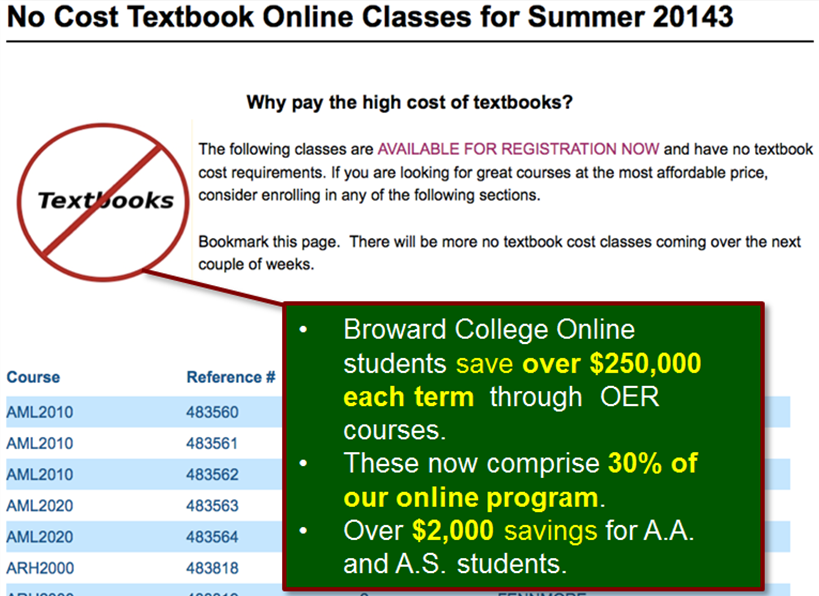Open Educational Resources: How Broward College Online Took the Dive
Published by: WCET | 5/1/2014
Tags: Collaboration/Community, Cost Of Instruction, Open Educational Resources, Teaching, Textbooks
Published by: WCET | 5/1/2014
Tags: Collaboration/Community, Cost Of Instruction, Open Educational Resources, Teaching, Textbooks
Today we welcome guest author, David Shulman, Campus President, Broward College Online, as he shares with us how Florida’s Global Campus made the commitment to and implemented open educational resources and other no-cost course materials.
Background
It’s no secret that the cost of higher education and the ballooning student indebtedness have become part of the national consciousness. In numbers this is starkly represented by a rise in student loan debt from $240 billion in 2003, to a trillion dollars in 2014. Yes, you read correctly, one trillion dollars….and that’s just tuition. We haven’t discussed the cost of textbooks and digital content in the affordability equation, yet the same decade has socked students with prices increases in excess of 80 percent.
Broward College prides itself on a low cost of tuition, but controlling external factors such as textbook and materials inflation is not feasible. After all, what influence could we have against publishing behemoths, let alone the secondary economies built around book rentals, used books, shared books, and even black-market copies. Yet leave it to Clayton Christensen’s disruption theory to step in and provide an Internet-enabled market solution that addresses these ancillary expenses. Indeed, some three years back Broward College Online, the virtual campus in our system, decided to take a stand and chart a new direction in quality, affordable courses by embracing the disruptive elements of Open Educational Resources (OER) and other technologically mediated solutions.
Why are we committed to OER and No-Cost Materials?

Affordable education is a deeply embedded value of Broward College, and the idea of taking the path less chosen through no-cost Open Educational Resources (OERs) was too good not to investigate. After all, if the learning outcomes could be demonstrated through mastery of competencies, why not try the OER approach and begin to chip away at that annual cost of $1,234….one course at a time.
Of course student behavior is also a factor. We’ve all heard the effects of high textbook costs, such as students forgoing the materials altogether, not starting class with the textbook due to insufficient funds, problems with correct editions, access code woes, and I could add several other impediments to learning that typically hit hard at the start of each new course.
We do have purely selfish motives for OER and other cost-neutral ways of serving students. Managing textbook versions is no easy feat for on-ground or online classes. Not only do new editions need to be ordered, but so courses themselves require redesigns or a total redo overs to meet new books. The latter is particularly challenging as the cycle of textbook changes has shortened over the past decade. As an online campus managing hundreds of courses each term, we are direct beneficiaries of the efficiencies that embedded OER and no-cost content solutions offer.
Our commitment to OER is also an added efficiency in light of textbook changes being considered by the State of Florida that would require transparency in textbook information inclusive of posting details several weeks prior to the start of registration. Clearly OER provides huge advantages in dealing with the rigors of compliance. National level politics are also revealing concern over textbook affordability, with U.S. Senators Dick Durbin (D-IL) and Al Franken (D-MN) introducing legislation mitigate costs by having textbooks accessible and free. The “Affordable College Textbook Act” seeks to develop online textbook content that can be freely licensed and repurposed.

How did we get here?
Our journey started back in 2012 with a decision to host an “e-Textbook & Digital Content Symposium.” This event provided a wonderful introduction to our College of OER and other emerging content delivery options. Faculty, neighboring institutions, and many vendors (AcademicPub, Apple, Cengage, Coursesmart, Courseload, Flat World, McGraw-Hill, Pearson) provided a view into the changes and trends in content ownership and delivery. The result of this signature event was the birth of Broward College Online’s commitment to OER and other zero cost course materials.
Over the next two years Broward College Online steadily began moving from the exploratory phase to building no textbook and no cost solutions for our master courses. We also contracted with Flat World Knowledge to use their library and authoring platform to embed OER and develop custom e-books, primarily in general education courses.
How are we doing?
Broward College Online is seeing an impact as our OER and no-cost catalog grows. Winter/Spring 2014 students saved over $250,000 and Summer 2014 is running at close to 30% OER and will far exceed the quarter million dollar mark. What’s even more encouraging is that success and retention are positive in these offerings, and enrollments are strong.
No cost and textbook free courses are now routinely advertised to prospective enrollees through LMS announcements, website advertising, and social media. Every new OER or no-cost material course that emerges from our course development process is heralded through these media to increase awareness of these courses and to drive enrollments to Broward College Online offerings.

What have we learned?
Building quality OER and no-material cost courses is not a simple task. Part of the learning curve at Broward College Online has been the realization that the process needs structure and support. Our approach has now evolved to include professional development and the services of our campus’s full time librarian. Apart from in-house training, Broward College Online also contracted with Lumen Learning to conduct OER workshops for staff and developers, as well as from Flat World Knowledge.
There are certainly pain points in the process, including the difficulty of replacing commercial adaptive and artificial intelligence technologies. Additionally, some content areas are simply far more intense and difficult to design OER-based courses. Examples of this have been Mathematics, Anatomy and Physiology, and Computer Science.
Where are we headed?
Our most ambitious project launches in Summer Term 2014, as we start accelerated A.S. and A.A. programs built around OER. The savings to a graduate of either degree will be at least $2,000. In addition, Broward College Online will continue to expand our catalog of OER and no-cost textbooks and materials, with an eye to realizing these outcomes:
We’ve just left the starting gate with this new initiative, and are on track to save Broward College Online students over three quarters of a million dollars this academic year alone. When this is combined with the lowest tuition in the state we see the value of our brand and credentials increasing in quality and decreasing in cost.
David Shulman, Ph.D.
Campus President
Broward College Online – Florida’s Global Campus
dshulman@broward.edu
online.broward.edu
9 replies on “Open Educational Resources: How Broward College Online Took the Dive”
While textbook costs of $200 and up do upset many students, the tuition costs are orders of magnitude greater at many institutions.
If students could purchase their educational resources for $10-30, there would be no real resistance due to cost.
Free resources are of uncertain quality and availability. It costs lots of money to review and select good resources, whether free or not. By paying a small fee for resources, you increase the likelihood that these resources will be kept up to date, current with new technology, and will be available from year to year. You also reduce the costs of reviewing a massive number of free resources of very uncertain quality and availability.
Some resources are not mere textbooks online. For example, science labs online must do more than just present text, images, and video (and virtual video in the form of the simulated animation).
The future of online resources will be much more interactive, requiring substantial investment in developing these technologies. A modest payment to the entities developing these will help to usher in the new online education world.
For all of these reasons and more, it makes no sense to depend exclusively on OER for course materials. You get what you pay for.
Agreed, and this is not a dogmatic approach that insists only OER is worthy. We also use Flat World e-books that are not OER, but do allow customization and inclusion of OER assets, as well as customization to our learning outcomes and institutional branding.
This entire area is very complex. Open is not always free. The less you pay, the more you usually have to put in yourself. Even free resources have the means to “monetize” their materials.
Librarians and instructional design specialists are yet another cost.
As a creator of content, my company partners with customers as requested and appropriate to build systems for them. Sometimes, it’s through capabilities built into our architecture in anticipation of these requests. Sometimes, it’s through customization beyond that.
Our focus has been on context expertise and pedagogy. We are continuing to move ahead even more aggressively than in the past with changes to the UI/UX.
These partnerships and continuing enhancement come from private organizations dedicated to improving learning. I cannot imagine a sufficient mass of people creating the same thing in online science labs in an open system approach. The niche is too small, and the expertises too specialized for it to work well.
[…] Open Educational Resources: How Broward College Online Took … […]
The article didn’t mention anything about learning outcomes. I wonder if Broward College has seen any change in the students ability to master the learning outcomes in the courses that are using OER resources.
So far outcomes are typically higher or equivalent. This is an interesting topic, as the development of the module around the learning outcome becomes tighter when the flow and sequencing of learning is integrated.
Harry –
Of course “open” does not mean “no cost.” The cost of licensing may be free, but there are costs of creating, adapting, and updating OER materials. Given the flexibility that is afforded faculty by using OER, if given the proper support, it is understandable why this is an attractive option.
Russ
Of course, some OERs are great. However, you must look behind the facade.
Sometimes, an OER has just been tossed out there with the hope that others will pick it up. Some may have been created with grants that are not renewed. The issue is one of a continuing community of people to maintain a given educational resource. The quality of this community and its size determine the value of the resource.
Many are attracted to OERs because they are “free.” No resource is truly free. A few online resources are relatively free. Apache comes to mind. The user base is huge and so it the developer community. Having used Apache, I can say that the cost in internal support is far from free. Internally, it’s a technical hodge podge that takes considerable effort to master. I put up with it only because of its quality and value, which I deem to be greater than my cost.
I should state that I have a bias because I created an online educational resource (a different sort of “OER”) that could not function as an open resource because of its internal complexity and issues with quality materials. In order to deliver the learning experience that I envisioned, this sort of complexity was necessary. I can see OERs that are relatively (important word, that) simple. It might be a video or some interactive images, for example. Really digging deeply into learning requires more, and that’s where I decided to go.
It is for the above reasons that I see OERs as a partial solution but not the entire solution. Just as you might build a car from parts scavenged from here and there and create a runnable vehicle, so using OERs from here and there can build a viable course. The units in a course are better if built to the purpose and designed to go together. Naturally, the course designer may be able to cut, mold, and shave the OERs to fit together better, but that is a cost.
Per Harry’s comments, this is why it is so invaluable to have a dedicated librarian and a team of instructional design specialists to assist in the process. It was also useful to our process to get training from professionals like Lumen Learning so that the differentiation of OER from other open content was understood in the design process, particularly to ensure intellectual property rights are observed.